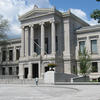More about Dance at Bougival
- All
- Info
- Shop

Sr. Contributor
Aptly named, Bougival was the place Impressionists went to get their boogie on.
Painting's a tough business to get in on, and everyone needs a break from the hustle. So when French art mogul Paul Durand-Ruel asked Renoir for three dance paintings, the artist knew exactly where one of them was going to show. The lady in Bougival, the one totally not having her partner all up in her grill, is Suzanne Valadon. An artist in her own right, and one of Renoir's early muses. She was the lady dance partner in two of the dance series for Durand, and Aline Charigot was in the third. Aline went on to marry Renoir, sure, but Suzanne hit that talent on the regular for years. She and Renoir even had a kid: the artist Maurice Utrillo. Renoir being Suzanne's baby daddy is still basically a rumor, but it's pretty hard to deny if you look at side-by-side pictures of him and Maurice.
The Museum of Fine Arts bought this painting for $150,000 in 1937, which translates into $2.5 million in present day monies. Keeping in mind that the museum whipped out that kind of skrilla during the Great Depression, you know they obviously had a huge thing for Bougival. Which most people do, considering it's always the talk of the town in whatever exhibition brings it out of Boston. Still, haters are everywhere. The #RenoirSucksatPainting movement blew up on social media and in the news when they picketed the MFA in 2015. They called for the museum to put away all their Renoirs, including Bougival, to make room for other, worthier art. The museum, of course, didn't budge, and the movement seems to have since faded out.
Featured Content
Here is what Wikipedia says about Dance at Bougival
Dance at Bougival (French: La danse à Bougival) is an 1883 oil-on-canvas painting by the French artist Pierre-Auguste Renoir, currently in the collection of the Museum of Fine Arts in Boston, Massachusetts, United States. Described as "one of the museum's most beloved works", it is one of three in a collection commissioned by Paul Durand-Ruel. It depicts a scene in the French village of Bougival, about 15 km from the center of Paris, a site utilized by many Impressionists besides Renoir including Claude Monet, Alfred Sisley, and Berthe Morisot.
The painting depicts two dancers surrounded by a lively scene of café goers. The painting's actual subjects are disputed, but it is well known for conveying the sense that they are in motion, making the viewer feel that they are actually there. Renoir used mostly pastel colors, but included a more vibrant hue in the hats of both the subjects. The larger group of paintings to which this one belongs is described as Renoir's last foray in Impressionism, and demonstrates the development of his artistic ability from his earlier works.
Check out the full Wikipedia article about Dance at Bougival


















